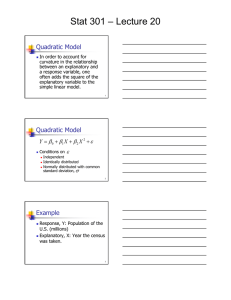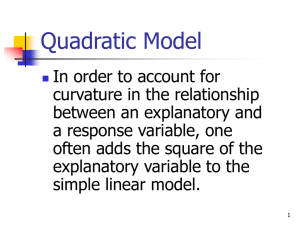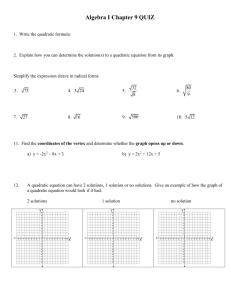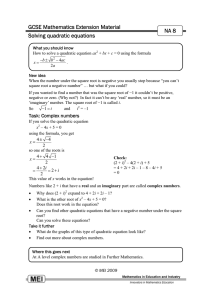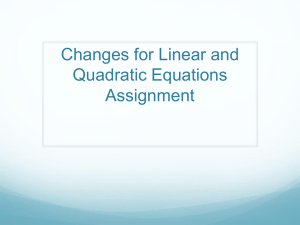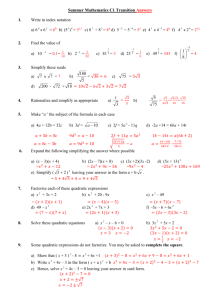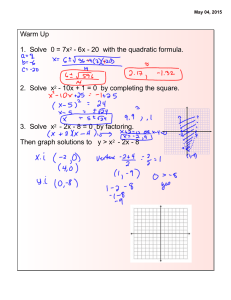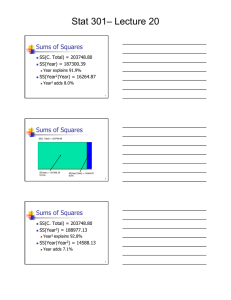Stat 301 – Lecture 19 Quadratic Model
advertisement
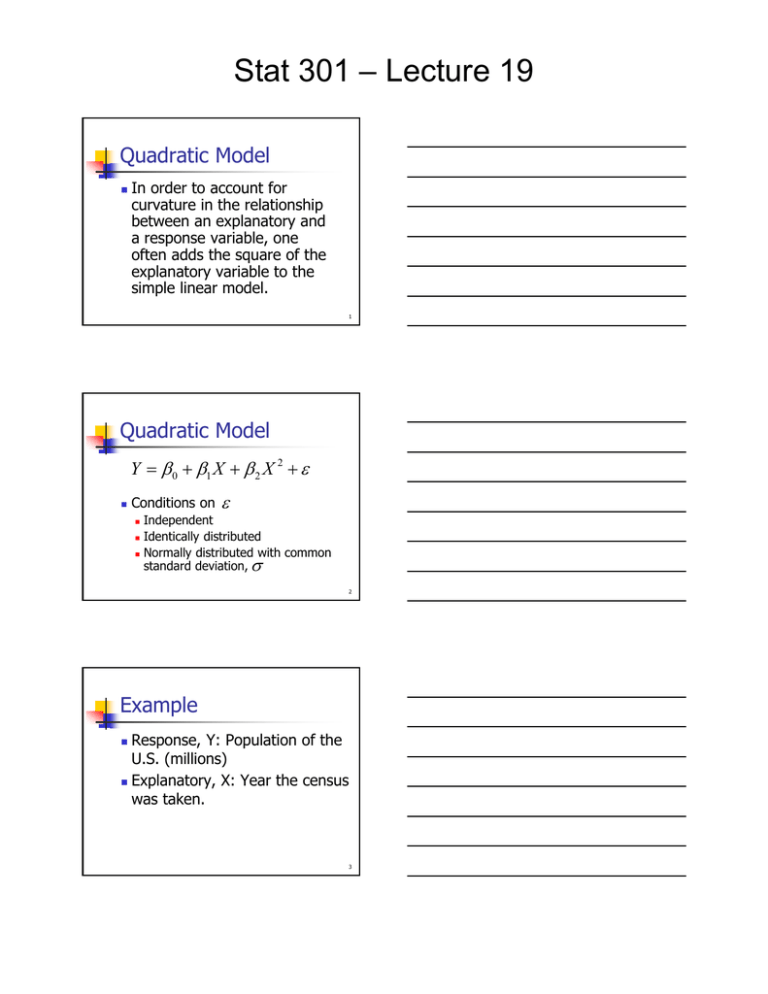
Stat 301 – Lecture 19 Quadratic Model In order to account for curvature in the relationship between an explanatory and a response variable, one often adds the square of the explanatory variable to the simple linear model. 1 Quadratic Model Y 0 1 X 2 X 2 Conditions on Independent Identically distributed Normally distributed with common standard deviation, 2 Example Response, Y: Population of the U.S. (millions) Explanatory, X: Year the census was taken. 3 Stat 301 – Lecture 19 Quadratic Model Predicted Population = 21952.25 –24.390*Year + 0.0067764*Year2 We cannot interpret the estimated slope coefficients because we cannot change Year by 1 while holding Year2 constant. 4 Model Utility F=11091.30, P-value<0.0001 The small P-value indicates that the quadratic model relating population to Year and Year2 is statistically significant (useful). 5 Statistical Significance Year (added to Year2) t=–39.87, P-value<0.0001 The P-value is small, therefore the addition of Year is statistically significant. 6 Stat 301 – Lecture 19 Statistical Significance Year2 (added to Year) t=42.10, P-value<0.0001 The P-value is small, therefore the addition of Year2 is statistically significant. 7 Quadratic Model R2=0.999 or 99.9% of the variation in population can be explained by the quadratic model. RMSE=3.03 million 8 Summary - Quadratic The model is useful. Each term is a statistically significant addition. 99.9% of the variation in population is explained by the quadratic model. 9 Stat 301 – Lecture 19 Prediction Year 2010 Predicted Population = 21952.25 – 24.390(2010) + 0.0067764*(2010)2 = 305.684 million Not bad as the actually figure in 2010 was 308.746 million. 10 Prediction for 2020 Year 2020 Predicted Population = 21952.25 – 24.390(2020) + 0.0067764*(2020)2 = 334.873 million 11 Prediction Year 1800 Predicted Population = 21952.25 – 24.390(1800) + 0.0067764*(1800)2 = 5.786 million Very close to the actual value of 5.308 million 12 Population Stat 301 – Lecture 19 13 14 Plot of Residuals The residuals wiggle around the zero line. Hard to say whether this is a pattern or not. The residuals for 1940 and 1950 stick out. The quadratic model over predicts for these years. 15 Stat 301 – Lecture 19 Possible explanation. 1940 census followed the Great Depression when immigration was very low. 1950 census followed WW-II when birth rates and immigration were low. 16 Quadratic Model There is still the issue of trying to interpret the coefficients in the quadratic model. If we change our explanatory variable by subtracting off 1900, we will be able to interpret the intercept. 17 Revised explanatory variable Use (Year – 1900) instead of Year as the explanatory variable. Note that 1900 is right in the middle of years we have census data for. 18 Stat 301 – Lecture 19 Quadratic Model Predicted Population = 74.166 + 1.360*(Year – 1900) + 0.0067764*(Year – 1900)2 The predicted population in 1900 is 74.166 million. 19 Quadratic Model Predicted Population = 74.166 + 1.360*(Year – 1900) + 0.0067764*(Year – 1900)2 Note that the coefficient for (Year – 1900) is the same as the coefficient for Year in the simple linear regression. 20 Simple Linear Regression For each additional year, the predicted population goes up, on average, by 1.360 million. (Year – 1900) is capturing the purely linear part of the relationship. 21 Stat 301 – Lecture 19 Quadratic Model Predicted Population = 74.166 + 1.360*(Year – 1900) + 0.0067764*(Year – 1900)2 The squared terms indicates that in addition to the average change per year, there is an adjustment to this rate of change the further away you are from 1900. 22 Ten Year Change 1880: Pred = 49.668 million 1890: Pred = 61.240 million An increase of 11.572 million over the 10 year period. Average increase of 1.1572 million per year. 23 Ten Year Change 1980: Pred = 226.371 million 1990: Pred = 251.495 million An increase of 25.124 million over the 10 year period. Average increase of 2.5124 million per year. 24

